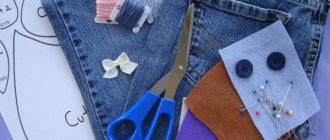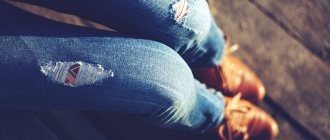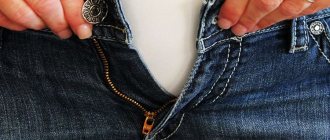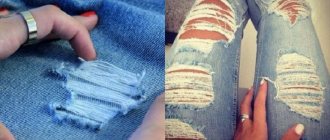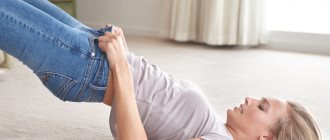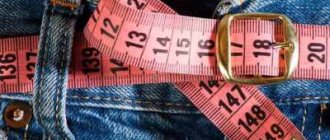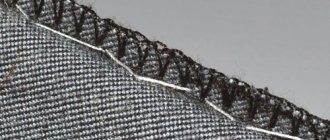When buying new jeans, many people are faced with the problem of long legs. It's rare that the length of a pair of trousers is perfect. Most people in this situation turn to the services of a tailor to sew a new item. However, you can do this work yourself. But for this it is necessary to take into account some nuances. After all, jeans have a specific color. In addition, the fabric is quite rough, which complicates the process.
The item must not lose its appearance or change its style after the manipulations. How to hem jeans correctly at home? You will learn about this from this article.
How to mark the length?
You should not measure the length using old jeans. After all, during wear, the item could become deformed. So the length of her pants may vary.
- Pair your new jeans with shoes and a belt.
- Look at yourself in the mirror from the side.
- Fold the jeans inside and pin the hem.
The length of medium-wide trousers should reach the heel. Skinny jeans should be leveled above it. Flared jeans should cover half the heel.
International jeans size charts for women and men
Often, especially in European online stores, you can find not a numerical, but a letter size grid - S, M, L... Such sizes do not provide information about the length of the model (this will need to be clarified in the description), but they well characterize the fit of the jeans at the waist and on the hips.
Women's jeans size chart
| Size | S | M | L | XL | XXL |
| Waist circumference | 68 | 72 | 77 | 82 | 87 |
| Hip girth | 94 | 98 | 102 | 106 | 110 |
On a sewing machine
To get a beautiful seam, it is advisable to choose thicker threads of the appropriate shade. How to hem jeans using a machine:
- Determine the length of the hem and leave an allowance of 2 cm.
- Iron the seams and secure everything with pins.
- Open the reverse stitch from the wrong side of the fabric.
- Pull out the decorative seam.
- From the wrong side, sew a new seam.
If the trouser fabric is thin and the hem is small, you can shorten the jeans without cutting the fabric. You just need to fold the excess inward and make a seam.
If the fabric is dense or has decorative abrasions, the work should be done differently. First you need to bend and shorten the trouser legs with an allowance of 3.5 cm. After this, you need to smooth the allowances in different directions and overcast them by hand. The factory hem needs to be folded, basted and sewn on a typewriter.
To better understand how to sew jeans on a sewing machine, watch this video.
Required tools and materials
The decorative seam along the bottom of the legs serves as decoration for the jeans, so when shortening you want to preserve the finish. Before work, you need to remember that an incorrectly measured length of 1-2 cm can disrupt the style of the trousers. To accurately hem jeans, you will need the following tools and materials:
- sewing machine for stitching on thick fabric;
- needles for processing denim material;
- measuring tape, chalk (soap marker);
- tailor's scissors or regular ones with a sharp edge;
- pins, thick threads to match the stitching of the pants;
- threads to match the color of the jeans for unnoticeable hemming.
Experts recommend measuring strictly along the right leg. Then you should carefully align the jeans - lay the item on a flat table surface, fold it inside with the legs, align it along the side seams, belt line, pockets and inner seam. There should be no folds or distortions on the fabric.
How to cut jeans correctly and not disturb the decorative appearance of the bottom of the trousers: first, try on the jeans, mark the hem and tuck them, and try them on again with the shoes. Then the right trouser leg is trimmed, the fitting is performed again and the left trouser leg is shortened. Before making a machine seam, the hem line is basted with contrasting threads.
Preserving the factory seam
The option of preserving the factory seam is suitable for those who do not want to cut the trouser legs. After all, it’s not so easy to shorten pants. If you are off by a couple of centimeters, the item will no longer fit well. Sometimes the bottom edge of the jeans is frayed, so a new seam can change the appearance of the product for the worse.
Some fabrics contain synthetic fibers and may shrink. If you don't trim the legs, you can always undo the stitching and make the legs longer.
Instructions:
- Find out how much fabric needs to be trimmed. To do this, put on jeans and fold the edge of the legs to the desired length. Pin the fold with a needle. Measure the length of the hem using a ruler.
- Remove the jeans and turn them inside out. Using a ruler, measure the required number of cm from the edge of the factory seam.
- Make an indent of approximately 5 cm and again set aside the desired length from the factory seam. Connect the resulting dots. Work both legs in this manner.
- Fold your pants inward. At the same time, connect the drawn line with the upper border of the factory hem.
- Connect the side seams and pin them with a pin. Pin the fabric in a few more places.
- Turn your jeans inside out. Join with a backstitch to the factory seam.
- Iron the seams and folds thoroughly. Secure the fold with a blind stitch.
It is recommended to make the seam with an indentation of 1.5-2 millimeters from the factory hem. In this case, it will straighten out easily.
If you need to shorten pants with fringe running along the bottom, hemming while preserving the decorative decoration will not look very nice. In this case, you will need to make a new decorative decoration yourself. First measure the length of the hem. Please note that fringe will increase the length of the legs. Using a thick needle or nail scissors, begin to pull out the cross threads. You will create an interesting decor. You can stitch over the fringe, this will prevent the threads from unraveling further.
general information
An inseam or inseam is a seam located on pants or leggings on the inside of the thigh. In other words, this is the distance from the groin to the end of the pant leg. It should be noted that the inside seam will always be shorter compared to the outside seam. On breeches and shorts, inseams are also considered crotch. Measuring internal seams is necessary not only when sewing a product, but also to determine the size in certain sports, for example, for cyclists. Knowing how to measure the length of a crotch seam with an assistant or on your own will make the sewing process much easier and the resulting product more comfortable. And the process of purchasing a new pair of trousers or leggings will become much easier. Try one of the methods below.
How to hem jeans by hand
You can shorten the legs without cutting the bottom with your own hands without a machine. This method is especially suitable for girls who often change their shoes. If you want to wear high-heeled jeans with shoes without them, you can quickly shorten them.
- Determine which part of the legs you need to trim and draw a line with tailor's chalk.
- Iron the hem on the wrong side.
- Turn your pants inside out. Using small stitches, sew the bottom of the jeans to the side seams.
This hem is temporary. It can be easily removed. This method comes in handy in situations where an item needs to be quickly adjusted to length.
How to mark a hem line for jeans
If the jeans are too wrinkled, for example after washing, then the lower parts of the legs can be ironed. It will be easier for you to apply marking lines on a flat surface of denim.
Before cutting your jeans, you need to accurately determine the shortening line and the width of the hem. Many “folk” ways for this have been invented, including this unique one, standing on a chair. Although, why not, if it’s convenient for you?
In the studio, the required length of jeans is measured like this. The customer, in jeans and without shoes, stands on a mat near a mirror with an additional lower view. In this mirror he will be able to clearly see what the length of his jeans will be. The excess jeans are folded inward and pinned. The hem line should touch the floor on the heel side. If women's jeans are to be worn with heels, then the lower back of the jeans should be even lower.
After this, you need to stand in front of the mirror in the shoes in which you are going to wear jeans, and the length is already adjusted taking into account the height of the heel and the wishes of the customer.
The measurement is taken along one leg of the right leg, since the right leg is usually longer than the left. The adjusted hem line (with shoes) is marked with chalk along the back side in one or three places. There is no need to mark anything on the front.
Now, using these marks (tag), you need to draw a line around the circle of the trouser leg. This is done on the desktop, as shown in this photo, using a long ruler. Below this marking we set aside 3-3.5 cm and draw another line. This is where you will need to cut the right leg of your jeans.
Now you can trim off the excess part of the right leg of your jeans with large tailor's scissors. Just don’t forget about the hem allowance. Half the work is done, the left half remains, well, everything seems simple here. Not at all, this is where the qualifications of a master are required.
Inexpensive jeans are sewn at the factory, without particularly checking the length of both legs. This is due to the technological features of mass tailoring. Therefore, half of the jeans have different lengths of both legs, albeit slightly, but they do.
Of course, in order to cut the second part, you need to fold the legs together (the back parts are inside) and mark a line on the second leg with chalk along the already cut part. But for some reason, when you note that everything seems to be perfectly straight, but in the finished form the jeans legs turn out to be different lengths.
The fastest way
If you need to quickly shorten your jeans, but don't have a sewing machine and don't want to make the seam yourself, you can use this method. The materials you will need are an iron and Moment glue.
- Measure the required length of jeans and trim off any excess fabric.
- Using glue, secure the seam allowance along the fold line and run an iron along it.
- Glue the folded edge in the same way.
The result may not look very nice. But if you have no other way to shorten your jeans, then this method is quite suitable.
Instead of glue, you can use adhesive tape.
The operating principle will be the same:
- Remove the factory seam, it will create unnecessary irregularities.
- Mark the fold line.
- Apply adhesive tape to the wrong side.
- Iron the product along the bottom.
Before cutting jeans, you need to align both legs
To avoid this, you need to carefully check the length of all lines of the side seams, internal seams, and waistband. You need to fold the jeans not along the front, but along the back, carefully smoothing out the folds with your palm. It doesn’t hurt to fasten the button and be sure to match the line of the belt; you can even pin the folded belt together with pins. Make sure that all the lines match, and only then cut off the second leg of the jeans with scissors. If it doesn’t work out exactly the first time, you can redo it and adjust the length during the fitting.
Fold the jeans together, smooth out all the wrinkles with your hand, and along the cut of the right leg, mark a cutting line for the left side of the jeans. The hem line should be perpendicular to the side seam of the jeans. No “bevels” should be made, otherwise the hem will not lay out nicely, pulling the front part of the fabric inward. Hem allowance: 3-3.5 cm for regular thickness denim and 4 cm for thick (winter) fabric with pile.
Turn the pant leg over and continue the hem line on the reverse side with chalk.
Now you can trim the left side of the jeans.
Be sure to mark the hem lines as you will need to press the double hem along them. By the way, there is no need to use chalk; soap is better suited for marking; after ironing, traces of soap can be easily removed, but chalk traces can sometimes remain and be difficult to remove. We used chalk so that you could better see these lines in the photo.
Blind seam
You can hem jeans at home using a hidden seam. It is made using vertical stitches.
- Insert the needle into the fold and then remove it.
- Pick up 2 or 3 strands of fabric.
- Insert the needle into the beginning of the stitch in the fold and bring it out from the left side at a distance of 5-7 millimeters.
- Carry out manipulations alternately on the main fabric and the fold fabric.
The thread should be in one addition. Only in this case the seam will be invisible.
Stitch seam
It is very convenient to shorten jeans using a sewn seam. How to do this correctly?
The stitch seam is made without gaps. The needle is inserted into the exit of the previous stitch. The direction of the seam is from right to left. The thread should be in the middle.
- Insert the needle to the right of the thread at a distance of 5 millimeters.
- On the left, bring it out at the same distance. You will get a beautiful stitch.
- After this, insert the needle into the beginning of the stitch. Output 5 millimeters to the left of the thread.
Hemming with trimming
This option is ideal for thick denim. After all, folds can be difficult to sew even using a sewing machine. It will also help out when you need to fold a very large amount of fabric.
It is better to wash your pants before cutting. This way you will avoid troubles associated with fabric shrinkage. Here are the step-by-step instructions:
- Measure the fabric to be trimmed. Put on your trousers and roll them up to the desired length. Pin the folds using pins. Measure the length of the hem.
- Turn the trousers inside out and set aside the required length from the edge. Indent to the side and make a line. Connect the dots with a line. On the other side, make a line at the same level.
- Step back 3 cm from the drawn line. Make marks and draw another line that will be parallel to the previous one.
- Trim along the bottom edge of the leg. Fold 1 cm upward, to the middle between the marked line and the end of the leg. After this, make a 2 cm hem and connect the fold with a line.
- Sew the jeans using a backstitch or machine stitch. Iron.
When cutting jeans, the factory seams will be broken. They need to be carefully joined so that the stitches match and the side seam does not move. This is worth taking into account so that you don’t have to do everything all over again.
Manual repair
A sewing machine can't always help. There are situations when manual work is necessary. Stock up on a thimble, a strong needle and patience.
Mend the hole unnoticed
You can manually sew up holes with right angles and in the shape of cut lines.
For all other holes you will need to use a different approach. Follow these steps:
- Select suitable darning threads;
- Make stitches throughout the selected area: back and forth;
- We make additional stitches between the threads, resulting in a patch. We thread the needle under the stitch and then over it;
- In one direction you get the base of the lattice, in the other you get a dense patch.
The easiest way to sew up a hole in jeans is appliqué. As an alternative, you can choose embroidery.
The selected applique will remain stitched with contrasting stitches.
The trends today are so diverse that all that remains is to choose the material in order to sew up the hole unnoticed.
You can choose lace or wool: any element will look organic.
When repairing damage, do not focus on the hole; place the patches as you see fit, as if it was the designer’s idea.
Jeans often have straight rips. When eliminating them, try not to overtighten the edges, make stitches close to each other. The threads should match the tone of the material so as not to draw attention to the darned areas.
Hemming using trouser tape
Buy trouser tape that has a suitable shade.
Cotton tape may shrink a lot after washing. Therefore, it is recommended to wash and dry it before use.
- Put on your jeans and measure the length you need.
- Use chalk to draw a shortening line. Set aside 2 cm and 1.5 cm from it. Draw a new line.
- Trim off any excess fabric. At the same time, leave an allowance of 3.5 cm.
- Baste the trouser tape to the bottom of the trouser legs. The thicker edge of the tape should match the edge of the pants.
- Sew the braid using parallel stitches.
- Iron the seam allowance up.
- Make another line on the wrong side. Thread a blue thread into the needle. The finishing thread, which is thicker, should be in the bobbin.
Due to the trouser braid, the edge of the legs will become tighter. Jeans will be worn for a long time and will not fray.
Ways to shorten a pair of jeans
Many denim pants feature nice distressed seams, mostly on the bottom. If you save them, the bending will not be noticeable. Pants can be hemmed in several ways:
- By typewriter;
- With braid;
- With the help of a web;
- With cuffs.
The process of taking measurements
There is also a creative way of folding pants. It consists in the use of finishing elements. Step-by-step work process:
- For finishing you can use various fabrics: real leather, denim material several shades darker;
- The seam can also be decorated at your discretion;
- You can make cuff cuffs out of white fabric and use colored material for the pocket edging.
A well-made fold, while maintaining a hemmed edge, helps to fit expensive trousers well, and the finishing gives a second life to your favorite trousers and will make an impression on people. It is also important to match your jeans correctly. They match almost any shoes, except summer slippers. Look good with shirts, tank tops or sweaters. Jeans are rightfully considered universal clothing. They are worn in all seasons all year round.
You might be interested in this: The procedure for taking measurements from a child: tables of typical figures
How to sew jeans at the waist
It's rare that the trousers you buy fit perfectly. Often they have to be sutured at the waist. This is where rubber bands come to the rescue.
- Measure your waist length from the back side, subtract 10 cm. You will get the length of the elastic band. Let's say the back length at the waist is 35 cm, which means you need an elastic band 25 cm long.
- On the wrong side of the trousers, leave an equal amount of space on both sides of the side seam. This distance should correspond to the length of the elastic band.
- At the ends of the segments, make cuts with scissors no more than 3 centimeters wide.
- Attach a pin to the end of the elastic. Pull the elastic from one end to the other.
- Pin one end of the elastic, then put on your pants and set the tension you need.
- Attach both ends to the hole using a needle back stitch.
The cuts can be finished with a buttonhole stitch. This will prevent the threads from fraying. Stitches should be made vertically.
